Page 39 of 602
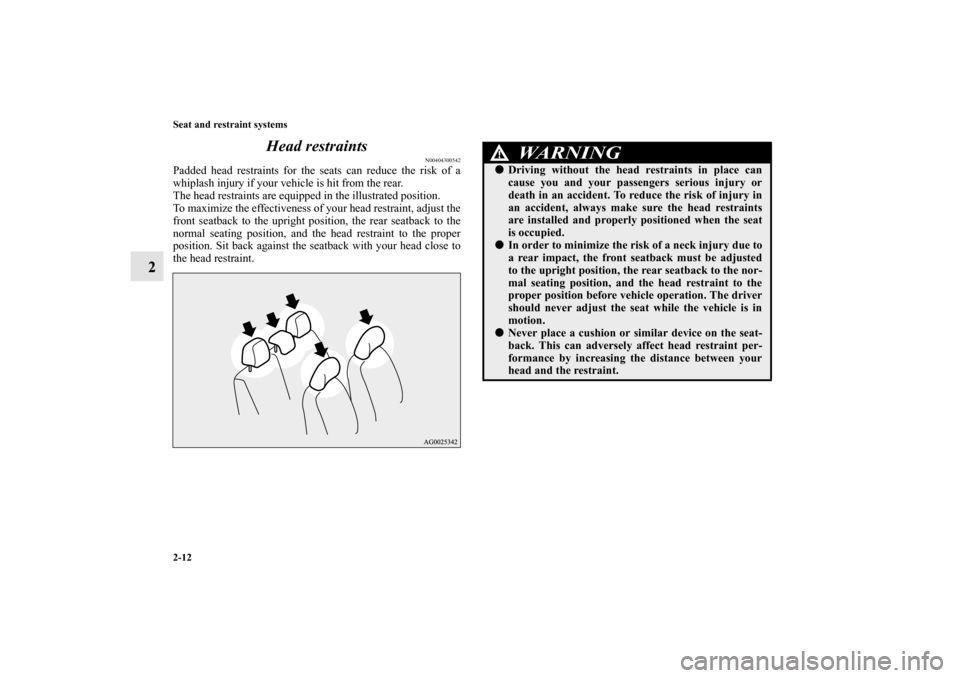
2-12 Seat and restraint systems
2Head restraints
N00404300542
Padded head restraints for the seats can reduce the risk of a
whiplash injury if your vehicle is hit from the rear.
The head restraints are equipped in the illustrated position.
To maximize the effectiveness of your head restraint, adjust the
front seatback to the upright position, the rear seatback to the
normal seating position, and the head restraint to the proper
position. Sit back against the seatback with your head close to
the head restraint.
WA R N I N G
!�Driving without the head restraints in place can
cause you and your passengers serious injury or
death in an accident. To reduce the risk of injury in
an accident, always make sure the head restraints
are installed and properly positioned when the seat
is occupied.�In order to minimize the risk of a neck injury due to
a rear impact, the front seatback must be adjusted
to the upright position, the rear seatback to the nor-
mal seating position, and the head restraint to the
proper position before vehicle operation. The driver
should never adjust the seat while the vehicle is in
motion.�Never place a cushion or similar device on the seat-
back. This can adversely affect head restraint per-
formance by increasing the distance between your
head and the restraint.
BK0120400US.book 12 ページ 2010年5月12日 水曜日 午前10時50分
Page 42 of 602
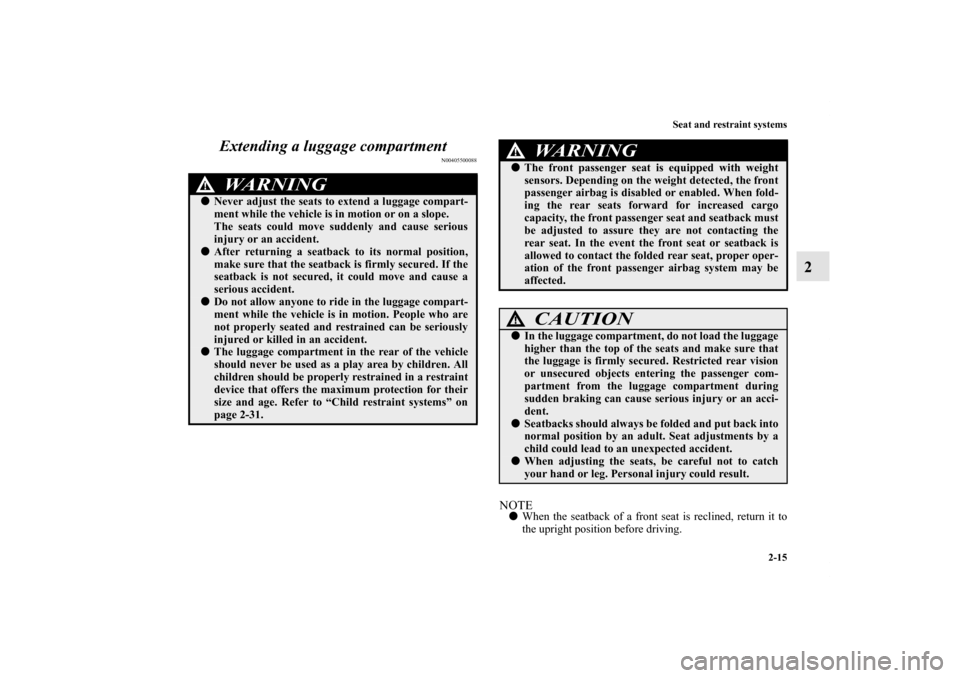
Seat and restraint systems
2-15
2 Extending a luggage compartment
N00405500088
NOTE�When the seatback of a front seat is reclined, return it to
the upright position before driving.
WA R N I N G
!�Never adjust the seats to extend a luggage compart-
ment while the vehicle is in motion or on a slope.
The seats could move suddenly and cause serious
injury or an accident.�After returning a seatback to its normal position,
make sure that the seatback is firmly secured. If the
seatback is not secured, it could move and cause a
serious accident.�Do not allow anyone to ride in the luggage compart-
ment while the vehicle is in motion. People who are
not properly seated and restrained can be seriously
injured or killed in an accident.�The luggage compartment in the rear of the vehicle
should never be used as a play area by children. All
children should be properly restrained in a restraint
device that offers the maximum protection for their
size and age. Refer to “Child restraint systems” on
page 2-31.
�The front passenger seat is equipped with weight
sensors. Depending on the weight detected, the front
passenger airbag is disabled or enabled. When fold-
ing the rear seats forward for increased cargo
capacity, the front passenger seat and seatback must
be adjusted to assure they are not contacting the
rear seat. In the event the front seat or seatback is
allowed to contact the folded rear seat, proper oper-
ation of the front passenger airbag system may be
affected.
CAUTION
!�In the luggage compartment, do not load the luggage
higher than the top of the seats and make sure that
the luggage is firmly secured. Restricted rear vision
or unsecured objects entering the passenger com-
partment from the luggage compartment during
sudden braking can cause serious injury or an acci-
dent.�Seatbacks should always be folded and put back into
normal position by an adult. Seat adjustments by a
child could lead to an unexpected accident.�When adjusting the seats, be careful not to catch
your hand or leg. Personal injury could result.
WA R N I N G
!
BK0120400US.book 15 ページ 2010年5月12日 水曜日 午前10時50分
Page 46 of 602
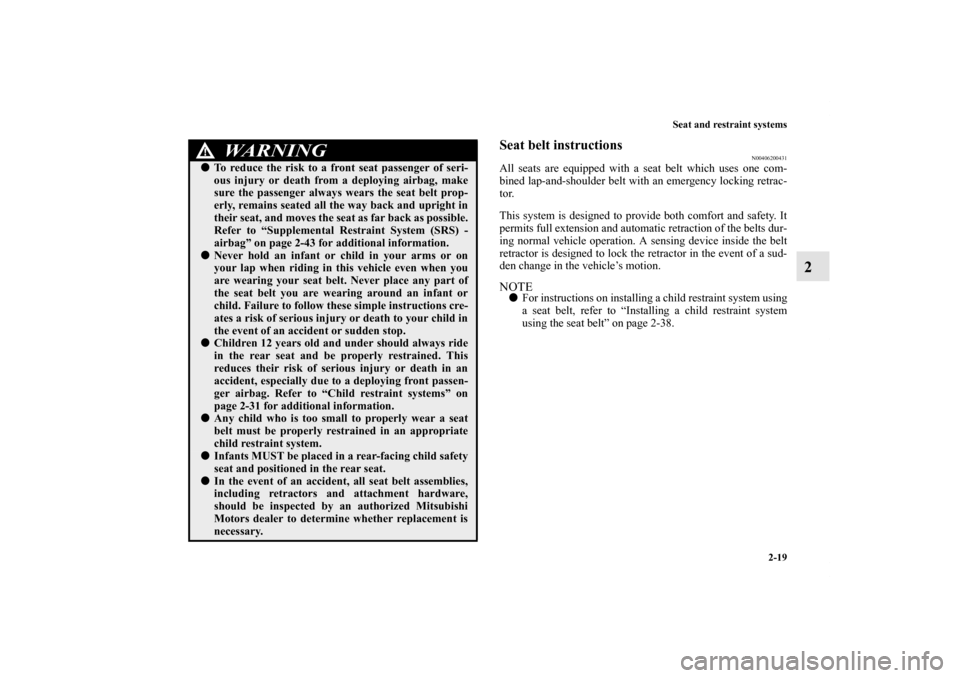
Seat and restraint systems
2-19
2
Seat belt instructions
N00406200431
All seats are equipped with a seat belt which uses one com-
bined lap-and-shoulder belt with an emergency locking retrac-
tor.
This system is designed to provide both comfort and safety. It
permits full extension and automatic retraction of the belts dur-
ing normal vehicle operation. A sensing device inside the belt
retractor is designed to lock the retractor in the event of a sud-
den change in the vehicle’s motion.NOTE�For instructions on installing a child restraint system using
a seat belt, refer to “Installing a child restraint system
using the seat belt” on page 2-38.
�To reduce the risk to a front seat passenger of seri-
ous injury or death from a deploying airbag, make
sure the passenger always wears the seat belt prop-
erly, remains seated all the way back and upright in
their seat, and moves the seat as far back as possible.
Refer to “Supplemental Restraint System (SRS) -
airbag” on page 2-43 for additional information.�Never hold an infant or child in your arms or on
your lap when riding in this vehicle even when you
are wearing your seat belt. Never place any part of
the seat belt you are wearing around an infant or
child. Failure to follow these simple instructions cre-
ates a risk of serious injury or death to your child in
the event of an accident or sudden stop.�Children 12 years old and under should always ride
in the rear seat and be properly restrained. This
reduces their risk of serious injury or death in an
accident, especially due to a deploying front passen-
ger airbag. Refer to “Child restraint systems” on
page 2-31 for additional information.�Any child who is too small to properly wear a seat
belt must be properly restrained in an appropriate
child restraint system.�Infants MUST be placed in a rear-facing child safety
seat and positioned in the rear seat.�In the event of an accident, all seat belt assemblies,
including retractors and attachment hardware,
should be inspected by an authorized Mitsubishi
Motors dealer to determine whether replacement is
necessary.
WA R N I N G
!
BK0120400US.book 19 ページ 2010年5月12日 水曜日 午前10時50分
Page 47 of 602
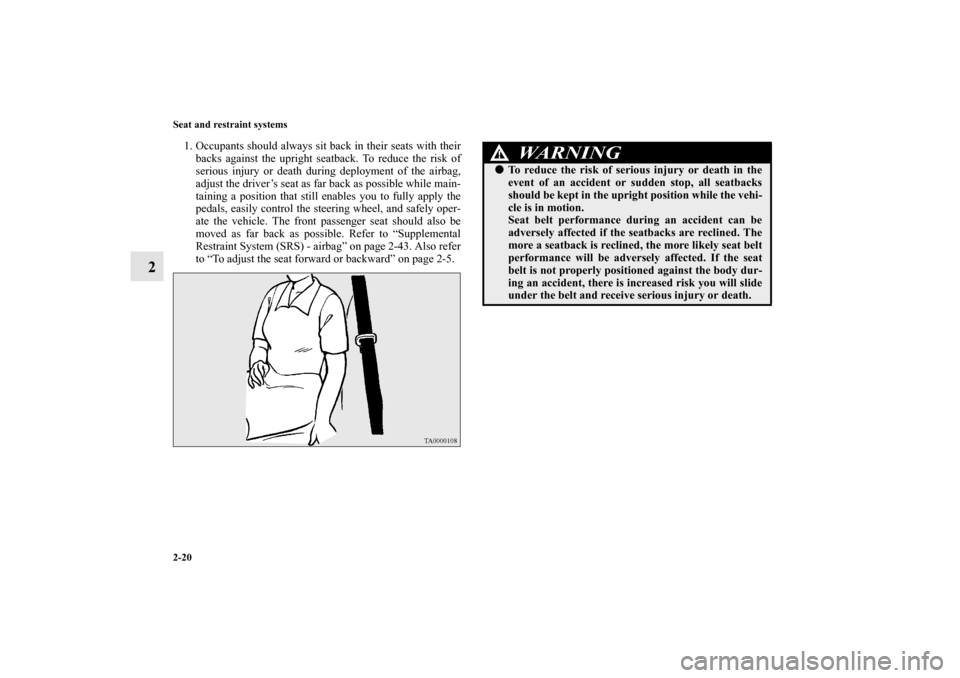
2-20 Seat and restraint systems
2
1. Occupants should always sit back in their seats with their
backs against the upright seatback. To reduce the risk of
serious injury or death during deployment of the airbag,
adjust the driver’s seat as far back as possible while main-
taining a position that still enables you to fully apply the
pedals, easily control the steering wheel, and safely oper-
ate the vehicle. The front passenger seat should also be
moved as far back as possible. Refer to “Supplemental
Restraint System (SRS) - airbag” on page 2-43. Also refer
to “To adjust the seat forward or backward” on page 2-5.
WA R N I N G
!�To reduce the risk of serious injury or death in the
event of an accident or sudden stop, all seatbacks
should be kept in the upright position while the vehi-
cle is in motion.
Seat belt performance during an accident can be
adversely affected if the seatbacks are reclined. The
more a seatback is reclined, the more likely seat belt
performance will be adversely affected. If the seat
belt is not properly positioned against the body dur-
ing an accident, there is increased risk you will slide
under the belt and receive serious injury or death.
BK0120400US.book 20 ページ 2010年5月12日 水曜日 午前10時50分
Page 54 of 602
Seat and restraint systems
2-27
2
Front passenger seat belt warning light
N00418300194
The front passenger seat belt warning light is located in the
instrument panel.
When the ignition switch is turned to the “ON” position or the
operation mode is put in ON, this indicator normally comes on
and goes off a few seconds later.
The light comes on when a person sits on the front passenger
seat but does not fasten the seat belt. It goes off when the seat
belt is subsequently fastened.
Adjustable seat belt shoulder anchor (front seats)
N00406300302
To move the anchor (A), press the lock knob (B) and slide the
anchor to the desired position.
WA R N I N G
!�Do not install any accessory or sticker that makes
the light difficult to see.
Anchor down Anchor up
BK0120400US.book 27 ページ 2010年5月12日 水曜日 午前10時50分
Page 55 of 602
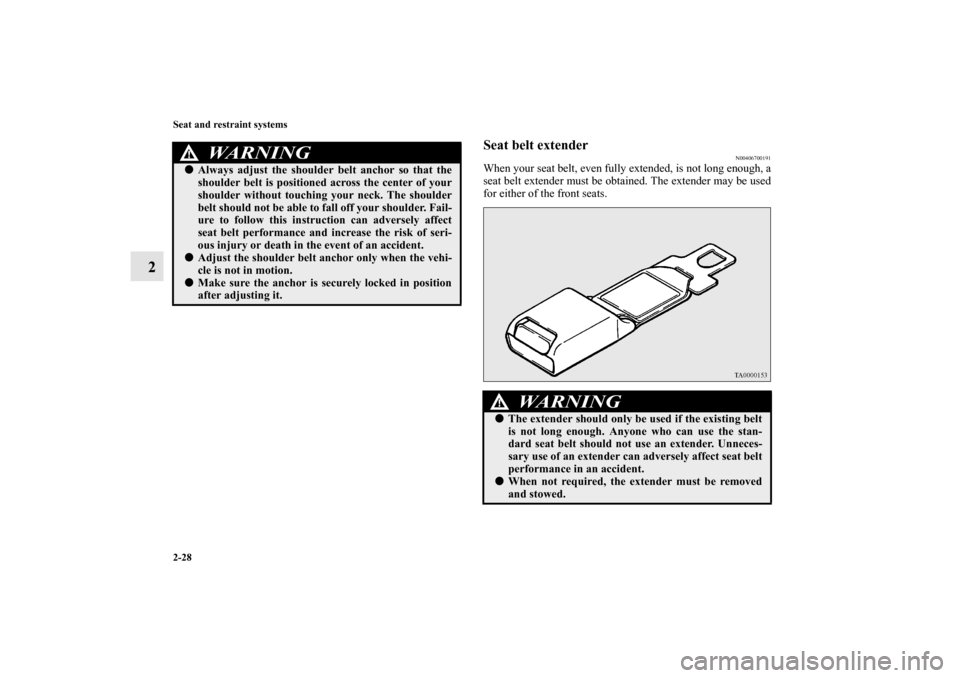
2-28 Seat and restraint systems
2
Seat belt extender
N00406700191
When your seat belt, even fully extended, is not long enough, a
seat belt extender must be obtained. The extender may be used
for either of the front seats.
WA R N I N G
!�Always adjust the shoulder belt anchor so that the
shoulder belt is positioned across the center of your
shoulder without touching your neck. The shoulder
belt should not be able to fall off your shoulder. Fail-
ure to follow this instruction can adversely affect
seat belt performance and increase the risk of seri-
ous injury or death in the event of an accident.�Adjust the shoulder belt anchor only when the vehi-
cle is not in motion.�Make sure the anchor is securely locked in position
after adjusting it.
WA R N I N G
!�The extender should only be used if the existing belt
is not long enough. Anyone who can use the stan-
dard seat belt should not use an extender. Unneces-
sary use of an extender can adversely affect seat belt
performance in an accident.�When not required, the extender must be removed
and stowed.
BK0120400US.book 28 ページ 2010年5月12日 水曜日 午前10時50分
Page 56 of 602
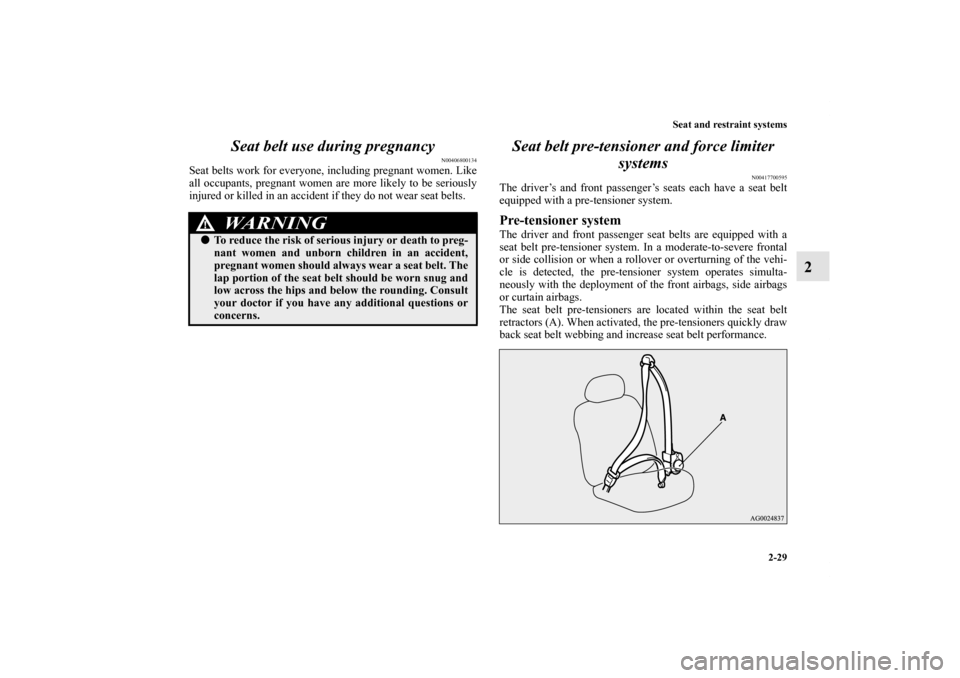
Seat and restraint systems
2-29
2 Seat belt use during pregnancy
N00406800134
Seat belts work for everyone, including pregnant women. Like
all occupants, pregnant women are more likely to be seriously
injured or killed in an accident if they do not wear seat belts.
Seat belt pre-tensioner and force limiter
systems
N00417700595
The driver’s and front passenger’s seats each have a seat belt
equipped with a pre-tensioner system.Pre-tensioner systemThe driver and front passenger seat belts are equipped with a
seat belt pre-tensioner system. In a moderate-to-severe frontal
or side collision or when a rollover or overturning of the vehi-
cle is detected, the pre-tensioner system operates simulta-
neously with the deployment of the front airbags, side airbags
or curtain airbags.
The seat belt pre-tensioners are located within the seat belt
retractors (A). When activated, the pre-tensioners quickly draw
back seat belt webbing and increase seat belt performance.
WA R N I N G
!�To reduce the risk of serious injury or death to preg-
nant women and unborn children in an accident,
pregnant women should always wear a seat belt. The
lap portion of the seat belt should be worn snug and
low across the hips and below the rounding. Consult
your doctor if you have any additional questions or
concerns.
BK0120400US.book 29 ページ 2010年5月12日 水曜日 午前10時50分
Page 62 of 602
Seat and restraint systems
2-35
2
Installing a child restraint system using the
LATCH (Lower Anchors and Tethers for chil-
dren) system
N00418800128
Lower anchor locationsThe outboard seating positions in the rear seat of your vehicle
are equipped with lower anchors for attaching child restraint
systems compatible with the LATCH system.NOTE�
The symbols on the seatback show the location of the
lower anchor points.
Tether anchor locations
N00418900174
Your vehicle has 3 attachment points on the backside of the
rear seats. These are for securing a child restraint system tether
strap to each of the 3 rear seating positions in your vehicle.
BK0120400US.book 35 ページ 2010年6月29日 火曜日 午後2時36分